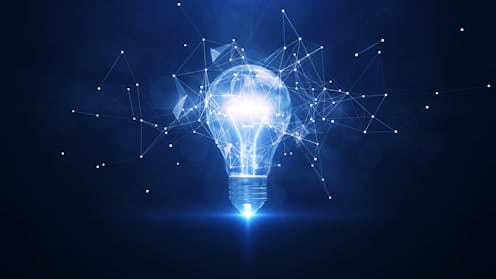Who invented the light bulb?
- Written by Ernest Freeberg, Professor of History, University of Tennessee

But Edison’s bulb was just one piece of a much more complicated system that included an efficient dynamo[13] – the powerful machine that generated electricity – plus a network of underground wires and new types of lamps. Edison also created the meter, a device that measured how much electricity each household used, so that he could tell how much to charge his customers.
Edison’s invention wasn’t just a science experiment – it was a commercial product that many people proved eager to buy.
Inventing an invention factory
As I show in my book[14], Edison did not solve these many technical challenges on his own.
At his farmhouse laboratory in Menlo Park, New Jersey[15], Edison hired a team of skilled technicians and trained scientists, and he filled his lab with every possible tool and material. He liked to boast that he had only a fourth grade education, but he knew enough to recruit men who had the skills he lacked. Edison also convinced banker J.P. Morgan[16] and other investors to provide financial backing to pay for his experiments and bring them to market.
Historians often say that Edison’s greatest invention was this collaborative workshop, which he called an “invention factory.” It was capable of launching amazing new machines on a regular basis. Edison set the agenda for its work – a role that earned him the nickname “the wizard of Menlo Park.”
Here was the beginning of what we now call “research and development” – the network of universities and laboratories that produce technological breakthroughs today, ranging from lifesaving vaccines to the internet, as well as many improvements in the electric lights we use now.
Sparking an electric revolution
Many people found creative ways to use Edison’s light bulb. Factory owners and office managers installed electric light to extend the workday[17] past sunset. Others used it for fun purposes[18], such as movie marquees, amusement parks, store windows, Christmas trees and evening baseball games.
Theater directors[19] and photographers[20] adapted the light to their arts. Doctors used small bulbs to peer inside the body during surgery. Architects and city planners, sign-makers and deep-sea explorers adapted the new light for all kinds of specialized uses. Through their actions, humanity’s relationship to day and night was reinvented – often in ways that Edison never could have anticipated.
Today people take for granted that they can have all the light they need at the flick of a switch. But that luxury requires a network of power stations, transmission lines and utility poles[21], managed by teams of trained engineers and electricians. To deliver it, electric power companies grew into an industry[22] monitored by insurance companies and public utility regulators.
Edison’s first fragile light bulbs were just one early step in the electric revolution that has helped create today’s richly illuminated world.
Hello, curious kids! Do you have a question you’d like an expert to answer? Ask an adult to send your question to CuriousKidsUS@theconversation.com[23]. Please tell us your name, age and the city where you live.
And since curiosity has no age limit – adults, let us know what you’re wondering, too. We won’t be able to answer every question, but we will do our best.
References
- ^ Curious Kids (theconversation.com)
- ^ CuriousKidsUS@theconversation.com (theconversation.com)
- ^ most important inventions in history (time.com)
- ^ are usually on the list (studyfinds.org)
- ^ a great idea (stock.adobe.com)
- ^ Thomas Edison (education.nationalgeographic.org)
- ^ a historian (history.utk.edu)
- ^ how electric lighting changed the U.S. (www.penguinrandomhouse.com)
- ^ chemist Joseph Swan (www.britannica.com)
- ^ exhibition on electricity in Paris (www.theiet.org)
- ^ lit up dozens of homes and offices (www.nyhistory.org)
- ^ Earl Morter, IEEE Global History Network/Con Edison, via Wikimedia (en.wikipedia.org)
- ^ an efficient dynamo (www.asme.org)
- ^ show in my book (www.penguinrandomhouse.com)
- ^ Menlo Park, New Jersey (www.menloparkmuseum.org)
- ^ banker J.P. Morgan (www.britannica.com)
- ^ extend the workday (stewartlighting.com)
- ^ fun purposes (americanhistory.si.edu)
- ^ Theater directors (www.britannica.com)
- ^ photographers (gamma-sci.com)
- ^ power stations, transmission lines and utility poles (www.youtube.com)
- ^ grew into an industry (mitpress.mit.edu)
- ^ CuriousKidsUS@theconversation.com (theconversation.com)
Authors: Ernest Freeberg, Professor of History, University of Tennessee
Read more https://theconversation.com/who-invented-the-light-bulb-255822

